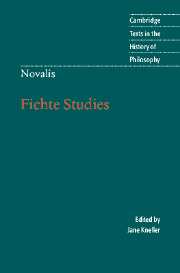Book contents
- Frontmatter
- Contents
- Preface
- Introduction
- Chronology
- Further reading
- Note on the text
- Fichte Studies
- Group I 1–210 (fall to early winter, 1795)
- Group II 211–287 (winter, 1795 to February, 1796)
- Group III 288–372 (February–March, 1796)
- Group IV 373–552 (March to early summer, 1796)
- Group V 553–568 (summer, 1796)
- Group VI 569–667 (summer to fall, 1796)
- Index
- Cambridge texts in the history of philosophy
Group V - 553–568 (summer, 1796)
Published online by Cambridge University Press: 05 June 2012
- Frontmatter
- Contents
- Preface
- Introduction
- Chronology
- Further reading
- Note on the text
- Fichte Studies
- Group I 1–210 (fall to early winter, 1795)
- Group II 211–287 (winter, 1795 to February, 1796)
- Group III 288–372 (February–March, 1796)
- Group IV 373–552 (March to early summer, 1796)
- Group V 553–568 (summer, 1796)
- Group VI 569–667 (summer to fall, 1796)
- Index
- Cambridge texts in the history of philosophy
Summary
REMARKS ON THE WISSENSCHAFTSLEHRE
553.1. Difference between fact and fact-act, page 4.
p. 5, a is a – seems to me to be nothing but a repetition of the bringing forth of the a to being. It can express a strengthening. No connotations are involved, and it qualifies therefore as a logical copula. Often such an identity judgment expresses a sharpened distinction – a sharp attention to the peculiar character of that which is in danger of being confused with something else. The sphere a is determined through the sphere a. a is the name of an unknown sphere. The first a is a characteristic posited, the second a is an essential posited – the former is presupposed, the latter is posited. The concept a is set in opposition to the a that is available.
Their common sphere, their scene, is the I – the subject. The first a is already available in the I – the other also – They are only connected.
/These reflections on this simple proposition must deliver to us the foundations of all philosophy/
a is a emerges from predication of the simple; simply on account of quantity, quality, relation, modality or their composites.
554. All explanation must begin with a fact. But from which fact must all explanation proceed? It must be a fact that lies at the basis of all other facts and needs no further explanation, but rather itself first makes possible all explanation.
- Type
- Chapter
- Information
- Novalis: Fichte Studies , pp. 163 - 172Publisher: Cambridge University PressPrint publication year: 2003

